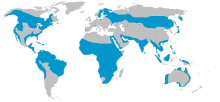Osprey
| Osprey | |
|---|---|
 |
|
| Nominate osprey subspecies from Nagarhole National Park. | |
| Scientific classification | |
| Kingdom: | Animalia |
| Phylum: | Chordata |
| Class: | Aves |
| Order: | Accipitriformes |
| Family: |
Pandionidae Sclater & Salvin, 1873 |
| Genus: |
Pandion Savigny, 1809 |
| Species: | P. haliaetus |
| Binomial name | |
|
Pandion haliaetus (Linnaeus, 1758) |
|
 |
|
| Global range of Pandion haliaetus | |
The osprey (Pandion haliaetus)—also called fish eagle, sea hawk, river hawk, and fish hawk—is a diurnal, fish-eating bird of prey with a cosmopolitan range. It is a large raptor, reaching more than 60 cm (24 in) in length and 180 cm (71 in) across the wings. It is brown on the upperparts and predominantly greyish on the head and underparts.
The osprey tolerates a wide variety of habitats, nesting in any location near a body of water providing an adequate food supply. It is found on all continents except Antarctica, although in South America it occurs only as a non-breeding migrant.
As its other common names suggest, the osprey's diet consists almost exclusively of fish. It possesses specialised physical characteristics and exhibits unique behaviour to assist in hunting and catching prey. As a result of these unique characteristics, it has been given its own taxonomic genus, Pandion and family, Pandionidae. Four subspecies are usually recognized, one of which has recently been given full species status (see below). Despite its propensity to nest near water, the osprey is not classed as a sea eagle.
The osprey was one of the many species described by Carl Linnaeus in his 18th-century work, Systema Naturae, and named as Falco haliaeetus. The genus, Pandion, is the sole member of the family Pandionidae, and used to contain only one species, the osprey (P. haliaetus). The genus Pandion was described by the French zoologist Marie Jules César Savigny in 1809.
The osprey differs in several respects from other diurnal birds of prey. Its toes are of equal length, its tarsi are reticulate, and its talons are rounded, rather than grooved. The osprey and owls are the only raptors whose outer toe is reversible, allowing them to grasp their prey with two toes in front and two behind. This is particularly helpful when they grab slippery fish. It has always presented something of a riddle to taxonomists, but here it is treated as the sole living member of the family Pandionidae, and the family listed in its traditional place as part of the order Falconiformes. Other schemes place it alongside the hawks and eagles in the family Accipitridae—which itself can be regarded as making up the bulk of the order Accipitriformes or else be lumped with the Falconidae into Falconiformes. The Sibley-Ahlquist taxonomy has placed it together with the other diurnal raptors in a greatly enlarged Ciconiiformes, but this results in an unnatural paraphyletic classification.
...
Wikipedia

